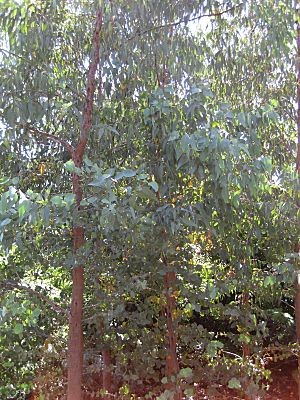Silver stringybark facts for kids
Quick facts for kids Silver stringybark |
|
|---|---|
 |
|
| Scientific classification | |
| Genus: |
Eucalyptus
|
| Species: |
alligatrix
|
Eucalyptus alligatrix, commonly known as the silver stringybark, is a special tree found only in southeastern Australia. It gets its name "stringybark" because of its rough, stringy bark on its trunk and branches. This tree has unique lance-shaped leaves, and its flower buds usually grow in groups of three. When it blooms, it has pretty white flowers, and after that, it produces cup-shaped or bell-shaped fruits.
Contents
What Does the Silver Stringybark Look Like?
The silver stringybark tree can grow quite tall, sometimes reaching up to 30 m (98.4 ft), which is about as tall as a 10-story building! It has thick, stringy bark that is deeply grooved on its trunk and branches.
Leaves and Flowers
Young plants and new shoots have leaves that are arranged in pairs. These leaves are broadly egg-shaped or round. They are about 20–45 millimetres (0.8–1.8 in) long and 25–50 mm (1.0–2.0 in) wide, and they don't have a stalk. These young leaves are a dull bluish-green color with a whitish, powdery coating.
As the tree grows, its adult leaves become bluish-green and shaped like a spear (lance-shaped). They are often curved, measuring 55–200 millimetres (2.2–7.9 in) long and 10–28 mm (0.4–1.1 in) wide. These adult leaves grow on a stalk about 10–20 millimetres (0.4–0.8 in) long.
The flower buds usually grow in groups of three, but sometimes you might see them in groups of seven. These groups are found where the leaves join the stem. Each group of buds sits on a small stalk about 4–6 mm (0.16–0.24 in) long. Each individual bud has an even smaller stalk, up to 2 mm (0.1 in) long.
The buds themselves are shaped like a diamond or a spindle. They are about 6–8 mm (0.24–0.31 in) long and 4–5 mm (0.16–0.20 in) wide. The cap of the bud, called the operculum, is cone-shaped and a little shorter than the base of the flower. The flowers are white. After the flowers, the tree produces woody fruits that are shaped like a cup, bell, or cone. These fruits are about 4–5 mm (0.16–0.20 in) long and 4–8 mm (0.16–0.31 in) wide.
How Did It Get Its Name?
The silver stringybark, Eucalyptus alligatrix, was officially named in 1991. Two scientists, Lawrie Johnson and Ken Hill, described it from a sample they found near Jamieson, Victoria.
The second part of its name, alligatrix, comes from a Latin word meaning "one who binds" or "she who binds together." This name was chosen because the tree has features that seem to connect two other eucalyptus species: Eucalyptus cinerea and Eucalyptus cephalocarpa. It's like it brings their characteristics together!
Different Types of Silver Stringybark
In 1995, two other scientists, Ian Brooker and Andrew Slee, described three different types, or subspecies, of Eucalyptus alligatrix:
- Eucalyptus alligatrix subspecies alligatrix: This type usually grows up to 15 m (49.2 ft) tall. When it's fully grown, its top part (called the crown) has both adult and young leaves. Its flower buds always appear in groups of three.
- Eucalyptus alligatrix subspecies limaensis: This type is known as the Lima stringybark. It can grow taller, up to 30 m (98.4 ft). When it's mature, its crown only has adult leaves, and its flower buds are always in groups of three.
- Eucalyptus alligatrix subspecies miscella: This type grows up to 15 m (49.2 ft) tall. Its crown only has adult leaves when it's mature. What's interesting is that its flower buds can be found in groups of both three and seven on the same tree!
Where Does It Grow?
This type of eucalyptus tree grows in woodlands, which are areas with many trees. You can often find it growing back in fields that were previously cleared.
Specific Locations for Each Subspecies
- Subspecies alligatrix is found in the Eildon, Jamieson, and Big River areas in Victoria, Australia.
- Subspecies limaensis is only known to grow near Swanpool in Victoria.
- Subspecies miscella has a very small area where it grows, near Rylstone in New South Wales.
Protecting the Silver Stringybark
Two of the subspecies, limaensis and miscella, are considered "Vulnerable." This means they are at risk of disappearing if we don't protect them. This status is given under an Australian Government law called the Environment Protection and Biodiversity Conservation Act 1999.
Threats and Recovery Efforts
For the Lima stringybark (subspecies limaensis), the main dangers include:
- Livestock (like cows or sheep) chewing on the trees.
- Soil becoming unhealthy.
- Invasive weeds taking over their habitat.
- Animals grazing too much.
To help this subspecies, a special plan has been created to help it recover.
Subspecies miscella is only found on one farm near Rylstone. There aren't many new trees growing there. The biggest threats to this type are:
- Grazing by livestock.
- Its natural home being destroyed.
- Fires happening at the wrong times or too often.


